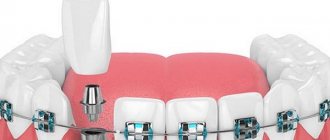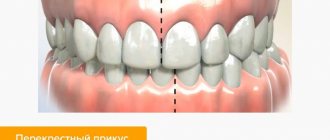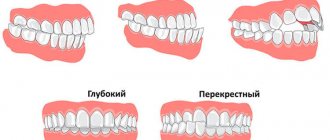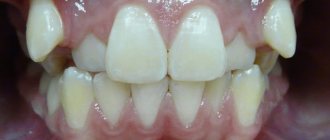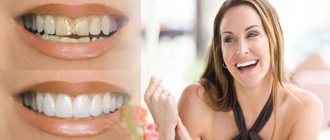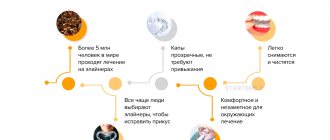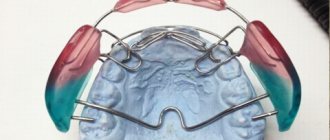When does a child need to have their bite corrected?
Parents should note all important details in the child’s unconscious behavior. Pay attention to how the child breathes, whether his mouth is often open, whether he snores in his sleep, what position the lower jaw is in, whether he likes to gnaw hard objects - these factors have a huge impact on the development of dental pathologies. Take a closer look at the posture and structure of the foot, these are also important indicators of possible violations. Did you find any deviations? Consult a professional.
Risk factors
- difficulties with nasal breathing, for example, due to adenoids or allergies;
- spinal column deformity;
- bad habits;
- genetic predisposition to dental anomalies;
- diseases of the central nervous system.
If the listed risk factors are present, treatment will be effective only with the participation of doctors from related fields. Therefore, it is best to contact myofunctional centers, which unite orthopedists, pediatric dentists, orthodontists and osteopaths. The joint work of specialists guarantees accurate diagnosis and successful resolution of the issue.
For problems with lip closure
There are several basic exercises:
- When the lips are compressed tightly, it is necessary to perform rotational movements with the tongue under the lips.
- The extended tongue is placed on the surface of the lower lip, while the upper lip, when closed quickly, should hit the tongue.
- You need to press your tongue to the roof of your mouth and open your mouth with the maximum possible amplitude. When you close your lips, you need to make a sound reminiscent of a hammer.
Each of the described exercises is performed first in a sitting position. As it becomes more difficult, you need to stand up.
An advanced gymnastics complex looks like this:
- The lower jaw moves forward until the lower incisors overlap the upper dentition.
This position is held for at least 10 seconds. After this, the jaw completely returns to its original position. - The previous exercise can be made more difficult by turning the head evenly. You should try to keep your jaw in an extended position.
- The head leans back, legs are set shoulder-width apart. The dentition moves forward until the marginal fusion of the jaw occurs.
Age for correcting malocclusion in children
You should think about visiting an orthodontist after teething. If necessary, the specialist will prescribe a comprehensive examination and radiography to identify the causes of dental anomalies. Then you should get advice from doctors in related fields. Specialists will determine contraindications, the likelihood of complications and assess the condition of the baby’s entire body. Based on the data obtained, the orthodontist will draw up a treatment plan for approximately 2 years with monthly clinic visits.
Is it possible for adults to straighten teeth without braces?
Contraindications to straightening teeth without braces are minimal. Of the main ones, only three can be distinguished:
- mental disorders
- indiscipline
- poor oral hygiene
People with an upset psyche simply will not be able to wear them, undisciplined people will not do it regularly, and those who do not take care of their teeth first need to attend to the issue of hygiene, and then begin to correct their bite. As for age restrictions, you can straighten crooked teeth without braces from the age of ten to twelve, after the eruption of the first premolars, and there is no upper age limit at all.
Devices for correcting malocclusion in children
In modern dentistry, there are all kinds of devices for correcting malocclusion in children, designed to achieve the following goals:
- prevention of bad habits;
- expansion of the jaw arch;
- correction of speech defects;
- normalization of the functioning of the masticatory muscles;
- tongue position control.
LM activators
These orthodontic structures stimulate the development of the jaw arch, chewing muscles, facial expressions of the child, and promote normal breathing. LM activators are also suitable for getting rid of bad childhood habits - for example, if a baby sucks fingers, bites lips, bites pencils or nails. Due to its effect on the gums and tongue, the device fixes the rudiments of teeth in the desired position and prevents the development of maxillofacial pathologies in the future.
Cap for correcting malocclusion in children
Correcting a child's bite at 3 years old requires minimal costs. At this age, the dental system is still very plastic, and treatment, as a rule, is limited to the use of a cap to correct the bite in children. It is worn only at night to straighten baby teeth and avoid problems in the future when they are replaced by molars. The cap is a bandage made of rubber straps that are fixed on the jaw. The device is also used to correct mesial occlusion - the design restrains the development of the lower jaw and allows the upper jaw to form correctly.
Orthodontic plates
To correct the bite of a child from the age of 4, plates are used - thanks to them, you can align the dentition or prevent them from moving, correct the shape of the palate, and slightly widen the jaw. However, more complex violations cannot be corrected using this device. Orthodontic plates are made from individual impressions and secured in the oral cavity with metal brackets on the outer teeth.
Trainer for correcting malocclusion in children
Trainers for correcting malocclusion in children are called silicone trainers. They are quite soft but durable mouthguards, and are used to correct the bite in a child after 5 years, when the teeth have already been replaced with permanent ones - this way the jaw will develop more correctly. These simulators come in two types:
- elastic and lightweight mouthguards for the correction of dentofacial abnormalities in children aged 6 - 8 years;
- solid and massive trainers for children 8 - 12 years old.
These are standard designs that are produced without taking into account the individual characteristics of the patient. There are no contraindications for their use, and the effectiveness of mouthguards allows you to finally solve problems with bite.
Bracket systems
The general name for devices for correcting malocclusion in children is removable orthodontic structures. They are suitable for children up to 12 years old and correct minor defects. For older children, the orthodontist will most likely recommend braces. They allow you to correct almost any dental anomaly, as they have a strong impact on the entire maxillofacial apparatus. For example, to correct distal occlusion in children, systems with two arches are used that move the teeth in the desired direction.
Facebow braces are effective in correcting deep bites in children because they inhibit the development of the upper jaw to encourage growth of the lower jaw.
If your child, on the contrary, has the upper jaw moved back and the lower jaw forward, correcting the child’s malocclusion will take a little longer, but braces will also cope with the task. In addition, the doctor may prescribe certain surgical procedures, such as lingual frenuloplasty.
Teeth straightening without braces versus a braces system
Braces systems are multifunctional, one might say universal, non-removable orthodontic structures for straightening teeth. With their help, you can correct many disorders, and age does not play a role - it is only desirable that the bones and gums are in a healthy condition.
Each tooth is located in a socket of the jaw bone and is fixed by connective tissue fibers. If you do not press hard on the wall of the socket, a slight divergence of the bone will occur. As a result, the tooth will begin to change its position. The formed cavity heals over time, fixing the tooth in its new position.
It will take some time to consolidate the results of treatment. There is a chance that after you finish straightening your teeth with braces, you will have to install
, which can be either plates or mouthguards with trainers. This is done to prevent the teeth from moving back to their original position. Retainers are usually worn for the same amount of time as braces, but sometimes much longer. However, these structures are not often used in orthodontic practice.
Bracket
Bracket translated from English. language means “bracket” and is a special fastening for each tooth. The bracket is fixed to the tooth using special glue so that it can be easily removed later.
Arc wire
A wire arch, in other words, a metal wire imitates the shape of the physiological dentition for a given patient. Throughout the treatment, the archwires are changed to more and more suitable ones to achieve the desired result.
Elastic ligature
An elastic ligature is a garter of the arch to the bracket. There are also non-ligature bracket systems - in them the desired effect is achieved due to different sections of the arches (from thin and round to thick and rectangular) and the design features of the bracket grooves.
Ring
Rings are supporting elements that are attached to molars. They are needed to ensure that the arc does not spontaneously leave the desired position.
Elastic traction
Elastic traction (elastic) is an optional element. Its presence is determined by the decision of the orthodontist. Elastics are attached to the braces and give them the desired direction and force of influence. According to the doctor's instructions, the patient must wear and change them independently every day.
Types of braces
Ceramic
This is the most discreet type of labial (vestibular) braces attached to the lips. They are quite easy to choose depending on the color of your teeth. Ceramic braces are highly durable and do not irritate the gums. Due to the characteristics of the material, they cannot be called a “budget option”, and they are larger in size than other types of braces.
Metal
They are a classic type of braces. Metal braces, made from surgical steel, are quite cheap and reliable. They can also be coated with a thin layer of silver or gold, which is important for people who are allergic to regular metal. Also, metal braces can be colored, have different shapes, etc.
Plastic
They are usually used to straighten teeth in children if, for certain reasons, metal braces are not used. There are also different options for their color and shape. I must say that plastic braces are quite cheap. However, there are also disadvantages: firstly, they are quite fragile, and secondly, they are easily painted with food coloring.
Sapphire
The basis of these braces is monocrystalline sapphire. They are characterized, first of all, by high strength and transparency. In addition, sapphire braces are not painted with food coloring and no plaque forms on them. In many ways, they are similar to ceramic braces, but the cost of sapphire braces is higher.
Combined
It is a mixture of materials (such as plastic and metal) used in treatment.
Lingual
They are completely invisible to others, as they are attached on the tongue side. Hence their name. As a rule, this type of braces is made of metal. Lingual braces are used by public figures, as well as those in a dangerous profession (to avoid injury to the cheeks and lips). The disadvantages of these braces include their negative impact on diction and a longer treatment period compared to vestibular braces.
Finally, it should be said that all orthodontic structures must be purchased from an orthodontist and be sure to follow the rules associated with wearing and caring for them, of course, depending on their specific type. Your doctor will also tell you more about this.
If you have problems with your gums, he will recommend you medications that have wound healing, analgesic, antiseptic, anti-inflammatory and other effects. These can be rinses, compresses, special gels or balms for gums, etc.
Be healthy!
Any orthodontist will tell you that braces have many advantages over straightening teeth without braces. After all, they have been used to eliminate dental anomalies for more than a hundred years. You can compare dental braces to a reliable, high-quality German car that will never go out of style, but you can find a more modern and no less high-quality analogue.
Alternative techniques
Mouth guards for bite correction
As an alternative to braces, the orthodontist may suggest a mouth guard to correct the bite in children over 17–18 years of age. With their help, it is possible to correct defects in the upper dentition and correct the bite on the lower jaw in children.
Myotherapy
Another alternative option for correcting malocclusion in children is myotherapy. The essence of this technique is to perform special exercises to correct the bite in children. As a result of regular training, the muscular system begins to work correctly, and the teeth are aligned. The peculiarity of this method is that it can be used both as an independent and as an additional means for correcting dental defects. It is suitable for children no older than four years old, so it is impossible to do without the supervision of an adult during the exercises.
However, myomotherapy is not suitable for every child, as it has the following contraindications:
- impaired mobility of the jaw arch;
- muscle hypertrophy;
- severe dental anomalies;
- deformation of the maxillofacial system after illness or injury.
Surgery
Surgery also applies to correcting malocclusions without braces in older children, but this method is not common and is used as a last resort. Correction of malocclusion in children under 12 years of age by surgery, as a rule, is carried out only for special indications. These include the following defects:
- congenital malformation of the jaw;
- facial asymmetry;
- chin dysplasia;
- skeletal abnormalities;
- deformation of the cranial vault.
In all other cases, the specialist will try to solve the problem in a less radical way, for example, with braces or prosthetics.
Basic principles
The formation of a bite is determined by the work of the muscles that are located in close proximity to the rows of teeth.
Disturbances in muscle function can lead to the development of defects. One of the most common methods of bite correction is myotherapy, the essence of which is to train the jaw muscles.
In orthodontics, this method can be used:
- as independent therapy;
- as part of complex treatment;
- as preparation for orthodontic correction;
- for preventive purposes.
Exercises can give positive results even with an incorrect bite.
It is important that the gymnastics be clear and simple, otherwise the effectiveness of the correction may be low.
Therapeutic exercises are prescribed by a doctor 2 months before the start of special orthodontic treatment. This is due to the fact that the therapeutic load on the teeth prepares them for the peculiarities of the force of the equipment.
In most cases, it is advisable to use gymnastics in conjunction with hardware treatment of defects and anomalies of the jaw.
The Rokabado myogymnastics complex, used for TMJ (temporomandibular joint) dysfunction, is supplemented with acupressure and autogenic training.
Exercises to correct bite in children
The orthodontist selects exercises to correct the bite individually for each child, taking into account the structural features of the jaw and the severity of the pathology. Myogymnastics can be performed by parents themselves, who have learned the technique from a specialist, or by teachers and nurses in groups of children with the same disabilities.
- The lesson includes several exercises for the muscles of the tongue and oral cavity.
- Hold a sheet of cardboard with your lips while breathing through your nose.
- Move your lower jaw forward, biting your upper lip with your teeth.
- Pull out your lips with a tube.
- Puff out your cheeks with your lips closed.
- Massage your lips.
- “Click” your tongue.
- Touch each tooth with your tongue one by one.
- Hold some water in your mouth while breathing through your nose.
Myogymnastics must be performed daily at the same time until fatigue appears, taking short breaks between exercises. Only in this case will it be effective and bring the expected results.
For circular muscles
Training the orbicularis muscles of the cheeks and mouth is an important component of myogymnastics for the face and is performed in cases of its insufficient performance, usually observed during breathing through the mouth.
Exercises are also carried out when the upper teeth are deformed. Muscle deficiency is recognized by the overweight of the muscle that lengthens the gap between the lips when smiling.
Muscle deficiency is recognized by the overweight of the muscle that lengthens the gap between the lips when smiling.
There are several basic exercises for orthodontic treatment of this muscle:
- Exercise No. 1. Bent little fingers are placed in the corners of the mouth. Treatment is carried out by slightly stretching the mouth and parallel muscle contraction. It is important that your lips do not turn out during training.
- Exercise No. 2. The training is performed using special equipment - the Friel interlabial disc. This device must be held with your lips for 60 seconds.
The likelihood of recurrence of defective inclination of the teeth of the upper jaw is practically excluded.
How much does it cost to correct malocclusion in children?
Correcting a bite in young children cannot be called expensive. Doctors use simple and inexpensive orthodontic appliances or recommend exercises. But an older child requires more serious treatment, and accordingly, the cost will be slightly higher. The cost of treatment depends on the severity of the pathology and the age of your child. The price of correcting defects with a plate or trainers for a 5-year-old child will vary from 3,000 to 6,000 rubles. Installing braces for children over 12 years of age will cost 100,000 - 300,000 rubles. Treatment with aligners, costing from 169,000 rubles, is available to adolescents aged 16–17 years.
Any dental correction in children should begin with a thorough examination. Correct and timely identification of problems makes it possible to eliminate dental anomalies in almost all patients. The success of treatment depends mainly on its timeliness. The sooner parents show their child to a professional, the greater the chance of eliminating the defect.
